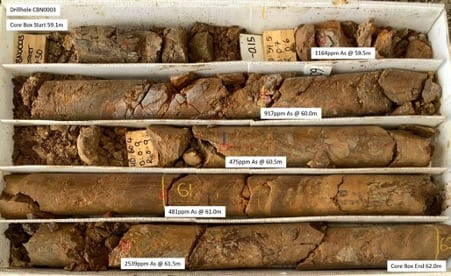Maiden Campaign Underway At Cap Burn Gold Project
NewPeak Metals Limited (ASX:NPM) has reported an encouraging update on the progress of the maiden drilling programne for the Cap Burn Gold Project in the Otago District of New Zealand.
Managing Director, David Mason, said to date five diamond drill holes for 522m have been completed with strong anomalous arsenic zones intersected. The program aims to test the main large, mineralised surface anomaly within the Cap Burn East area.
“We are excited to have encountered elevated levels of arsenic at depth given that is a common feature of Gold deposits along the Otago Schist Belt,” Mr Mason said.
“This, coupled with the size of the surface anomaly (1000m by 1000m), gives us cause to be optimistic at this early stage, particularly as the drilling to date has been along the margins of the surface anomaly. We look forward to completing the program involving the planned holes throughout the anomaly early in the New Year.”
Mr Mason said the presence of many of the key characteristics of orogenic Gold deposits of the Otago Schist Belt, in the recent drilling at Cap Burn, is encouraging and gives support to the current geological interpretation and mineralisation model. This model points to the Cap Burn Gold Project as having significant potential for the discovery of a large Gold system, similar to others in the region.
Drilling at Cap Burn commenced on the most eastern line of the planned holes in Target 1, due to access restrictions. Holes were drilled vertically to intersect the low angle, north-east dipping foliation, mapped at surface. Detailed logging and processing of the diamond core is ongoing with sampling due for completion prior to Christmas. Samples will be sent to the SGS laboratory, Westport, New Zealand for Gold assaying with first results expected at the end of January.
Analysis of the core using an Olympus Vanta M Portable XRF, at regular 0.5m locations down the hole has identified multiple anomalous (>100ppm) arsenic intervals within the core tested to date. Anomalous values range from 100pmm to over 4,000ppm over drill intersections of up to 10m in thickness.
Mr Mason said these intervals are often associated with structural zones (breccias and shear zones), quartz, weak silica alteration, and sulphides. This material is oxidised at a depth of over 60m as structures have allowed oxidation to penetrate deeper.
Whilst only indicative in nature the XRF results confirm the link between the surface gold and arsenic results, with the underlying geology. The orogenic Gold deposits of the Otago Schist Belt contain arsenic, predominantly as arsenopyrite, which is consistently associated with Gold.
Mr Mason said Arsenic to Gold, at a ratio of 1,000:1 (i.e. 1,000ppm As suggests a possible grade of 1g/t Au) is typical of many of the Otago Schist Belt deposits. This correlation has been confirmed at Cap Burn following analysis of Gold and arsenic results from surface rock chip sampling. Occurrences of graphite have also been identified within a number of shear zones in the recent drilling.
He said the presence of graphite in the main Hyde-Macraes Shear Zone is a feature of note at OceanaGold’s Macraes Mine and is the result of hydrothermal processes that accompanied Gold mineralisation. The Macraes Mine, owned by OceanaGold, has a current JORC Measured and Indicated resource of 3.5 million ounces Gold.












